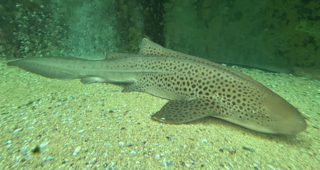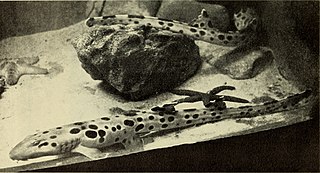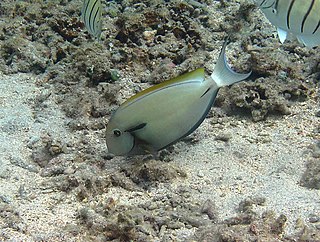
Carpet sharks are sharks classified in the order Orectolobiformes. Sometimes the common name "carpet shark" is used interchangeably with "wobbegong", which is the common name of sharks in the family Orectolobidae. Carpet sharks have five gill slits, two spineless dorsal fins, and a small mouth that does not extend past the eyes. Many species have barbels.

The zebra shark is a species of carpet shark and the sole member of the family Stegostomatidae. It is found throughout the tropical Indo-Pacific, frequenting coral reefs and sandy flats to a depth of 62 m (203 ft). Adult zebra sharks are distinctive in appearance, with five longitudinal ridges on a cylindrical body, a low caudal fin comprising nearly half the total length, and usually a pattern of dark spots on a pale background. Young zebra sharks under 50–90 cm (20–35 in) long have a completely different pattern, consisting of light vertical stripes on a brown background, and lack the ridges. This species attains a length of 2.5 m (8.2 ft).

The Hemiscylliidae are a family of sharks in the order Orectolobiformes, commonly known as longtail carpet sharks and sometimes as bamboo sharks. They are found in shallow waters of the tropical Indo-Pacific.

The coral catshark is a species of coloured catshark belonging to the family Atelomycteridae. It is common on shallow coral reefs across the Indo-West Pacific, from Pakistan to New Guinea. Reaching up to 70 cm (28 in) in length, the coral catshark has an extremely slender body, a short head and tail, and two dorsal fins that are angled backwards. It can be identified by the numerous black and white spots on its back, sides, and fins, which often merge to form horizontal bars. Furthermore, adult males have distinctively long and thin claspers.

The epaulette shark is a species of longtailed carpet shark of the family Hemiscylliidae, found in shallow, tropical waters off Australia and New Guinea. The common name of this shark comes from the very large, white-margined black spot behind each pectoral fin, which are reminiscent of military epaulettes. A small species usually under 1 m (3.3 ft) long, the epaulette shark has a slender body with a short head and broad, paddle-shaped paired fins. The caudal peduncle comprises over half the shark's length. Adults are light brown above, with scattered darker spots and indistinct saddles.

The Arabian carpetshark is a species of carpet shark in the family Hemiscylliidae, inhabiting coral reefs and other shallow coastal habitats from the Persian Gulf to India. Reaching 78 cm (31 in) long, this shark is characterized by a slender, plain brown body, and by two dorsal fins with straight trailing margins and the second smaller but longer-based than the first. The Arabian carpetshark feeds on bony fishes and invertebrates. Reproduction is oviparous with an annual cycle; females deposit egg capsules four at a time and the young hatch after 70–80 days. This small shark is often captured as bycatch but rarely used by humans. It has been assessed as Near Threatened by the International Union for Conservation of Nature (IUCN), as there is increasing fishing pressure and habitat degradation within its range. It does well in aquariums and has been bred in captivity.

The Indonesian speckled carpetshark, Hemiscyllium freycineti, is a species of bamboo shark in the family Hemiscylliidae. It is found in the shallow ocean around the Raja Ampat Islands in West Papua, Indonesia, but was formerly believed to be more widespread. This was due to confusion with H. michaeli, a species described from eastern Papua New Guinea in 2010. Compared to that species, the spots on H. freycineti are smaller, more rounded or slightly elongated in shape, and tend to darken at regular intervals forming 8-9 vertical bars on the body and tail. Furthermore, the large black spot behind the pectoral fin is more clearly defined in H. michaeli than in H. freycineti. Confusingly, some books with illustrations and photos labelled as H. freycineti actually show H. michaeli.

The Papuan epaulette shark, Hemiscyllium hallstromi, is a bamboo shark in the family Hemiscylliidae found around southern Papua New Guinea, between latitudes 7° S and 10° S, and longitude 144° E and 146° E. Its length is up to 75 cm.

The hooded carpetshark is a bamboo shark in the family Hemiscylliidae found around Papua New Guinea, between latitudes 5° S and 10° S, and longitude 144° E and 153° E. Its length is up to 75 cm. Like other longtailed carpetsharks, it can use its strong pectoral fins to walk on land for a short period of time. The hooded carpetshark is heavily wanted in the aquarium trade, the result is making this shark endangered.

The speckled carpetshark, Hemiscyllium trispeculare, is a bamboo shark in the family Hemiscylliidae found around north and west Australia between latitudes 8° S and 22° S, and longitude 114° E and 152° E. Its length is up to 79 cm, and it inhabits shallow coral reefs. It is also kept in aquaria. The speckled carpetshark is closely related to the epaulette shark

Hemiscyllium is a genus of sharks in the family Hemiscylliidae.

Acanthurus nigricauda, the epaulette surgeonfish, black-barred surgeonfish, eye-line surgeonfish, shoulderbar surgeonfish, white-tail surgeonfish or blackstreak surgeonfish, is a species of marine ray-finned fish belonging to the family Acanthuridae, the surgeonfishes, unicornfishes and tangs. It is native to the Indo-Pacific region.

Hemiscyllium galei, the Cenderawasih epaulette shark, is a species of bamboo shark in the family Hemiscylliidae. Together with H. henryi, it was only scientifically described in 2008 by Gerald R. Allen and Mark V. Erdmann. At present, H. galei is only known from depths of 2 to 4 metres at reefs in the Cenderawasih Bay in West Papua, Indonesia. The largest known specimen was 56.8 centimetres (22.4 in) long. It can be separated from its relatives by the combination of seven relatively large dark spots along the side of the body, white markings on the edge of its dark dorsal saddles and other scattered white spots on the upper side.
The Triton epaulette shark is a species of bamboo shark in the genus Hemiscyllium, that is composed of nine morphologically similar, yet distinct, sharks that are geographically restricted to New Guinea and northern Australia. Hemiscylliidae are small nocturnal sharks aptly named "walking sharks" who exhibit a "crawling" movement while foraging on the ocean floor for fish and benthic invertebrates.

The longfin grouper, also known as the longfin rockcod, bar-breasted rock-cod, Gilbert's rock-cod, honeycomb rockcod, spotted groper or wirenet cod, is a species of marine ray-finned fish, a grouper from the subfamily Epinephelinae which is part of the family Serranidae, which also includes the anthias and sea basses. It is found in the Western Pacific Ocean.

Hemiscyllium halmahera, or the Halmahera epaulette shark, is a species of bamboo shark from Indonesia. This species is described from two specimens collected near Ternate island in 2013, off the coast of larger Halmahera island. This species is most similar to Hemiscyllium galei, found in West Papua, but looks strikingly different in its pattern of spots. While H. galei has seven large, dark spots on each side of its body, H. halmahera has a brown color with clusters of brown or white spots in polygon configurations all over its body. These small sharks are like other bamboo sharks, in that they use their pectoral fins to "walk" along the ocean floor.
Pomacentrus aurifrons, the yellowhead damselfish, is a species of ray-finned fish from the family Pomacentridae, the damselfishes and clownfishes. It is found in the western Pacific Ocean.
Ronald Strahan (1922–2010) was a zoologist, historian and author of works on the fauna of Australia.

Latent sling-jaw wrasse is a species of ray-finned fish from the wrasse Family Labridae which is associated with reefs in the south-western Pacific Ocean.


















